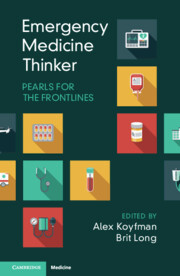Book contents
- Emergency Medicine Thinker
- Emergency Medicine Thinker
- Copyright page
- Contents
- Contributors
- Introduction
- Section 1 Decision-Making
- 1 On Deciding to Not Decide
- 2 What Makes Emergency Medicine Decision-Making Unique and Why?
- 3 Pediatric Emergency Medicine Approach: Be Vigilant but Be Reasonable
- 4 Decision-Making in Emergency Medicine
- 5 Emergency Medicine Medical Decision-Making
- 6 Decisions
- 7 Emergency Thinking and Behavior
- 8 Emergency Medicine Decision-Making
- 9 Emergency Medicine Decision-Making
- 10 Emergency Medicine Thinking and Cognitive Load Considerations
- 11 Decision-Making in Uncertainty
- 12 Unlearning and Thinking Differently
- 13 Decision-Making in Emergency Medicine
- 14 An Object in Motion
- 15 Too Little or Too Much?
- 16 Decision-Making in Emergency Medicine
- 17 Medical Decision-Making in the Emergency Department: Balancing the Patient’s Health with the Clinician’s Perception of Risk
- Section 2 Clinical Pearls
- Index
9 - Emergency Medicine Decision-Making
Is This a Bug or a Feature?
from Section 1 - Decision-Making
Published online by Cambridge University Press: 14 March 2025
- Emergency Medicine Thinker
- Emergency Medicine Thinker
- Copyright page
- Contents
- Contributors
- Introduction
- Section 1 Decision-Making
- 1 On Deciding to Not Decide
- 2 What Makes Emergency Medicine Decision-Making Unique and Why?
- 3 Pediatric Emergency Medicine Approach: Be Vigilant but Be Reasonable
- 4 Decision-Making in Emergency Medicine
- 5 Emergency Medicine Medical Decision-Making
- 6 Decisions
- 7 Emergency Thinking and Behavior
- 8 Emergency Medicine Decision-Making
- 9 Emergency Medicine Decision-Making
- 10 Emergency Medicine Thinking and Cognitive Load Considerations
- 11 Decision-Making in Uncertainty
- 12 Unlearning and Thinking Differently
- 13 Decision-Making in Emergency Medicine
- 14 An Object in Motion
- 15 Too Little or Too Much?
- 16 Decision-Making in Emergency Medicine
- 17 Medical Decision-Making in the Emergency Department: Balancing the Patient’s Health with the Clinician’s Perception of Risk
- Section 2 Clinical Pearls
- Index
Summary
Almost every specialty plays to win. To nail the diagnosis. Emergency medicine (EM) is different. Emergency medicine plays not to lose. This is one of the reasons why EM is so frustrating for the House of Medicine. The mindset is completely flipped. What does “playing not to lose” mean? It’s more than the adage of think worst first. Playing not to lose prevents immediate harm or deterioration, stabilizing when you have no idea what’s causing the patient’s condition (and may never know). Do other fields share this mindset? To a degree, yes, but it doesn’t undergird their every encounter. Playing not to lose is what allows you to act as a safety net so that someone doesn’t go home and die or have a preventable adverse outcome. Will you get it wrong? There are subacute, subtle, or atypical presentations of life-threatening diseases that you will miss. That’s just a fact of the job.
- Type
- Chapter
- Information
- Emergency Medicine ThinkerPearls for the Frontlines, pp. 70 - 73Publisher: Cambridge University PressPrint publication year: 2025

